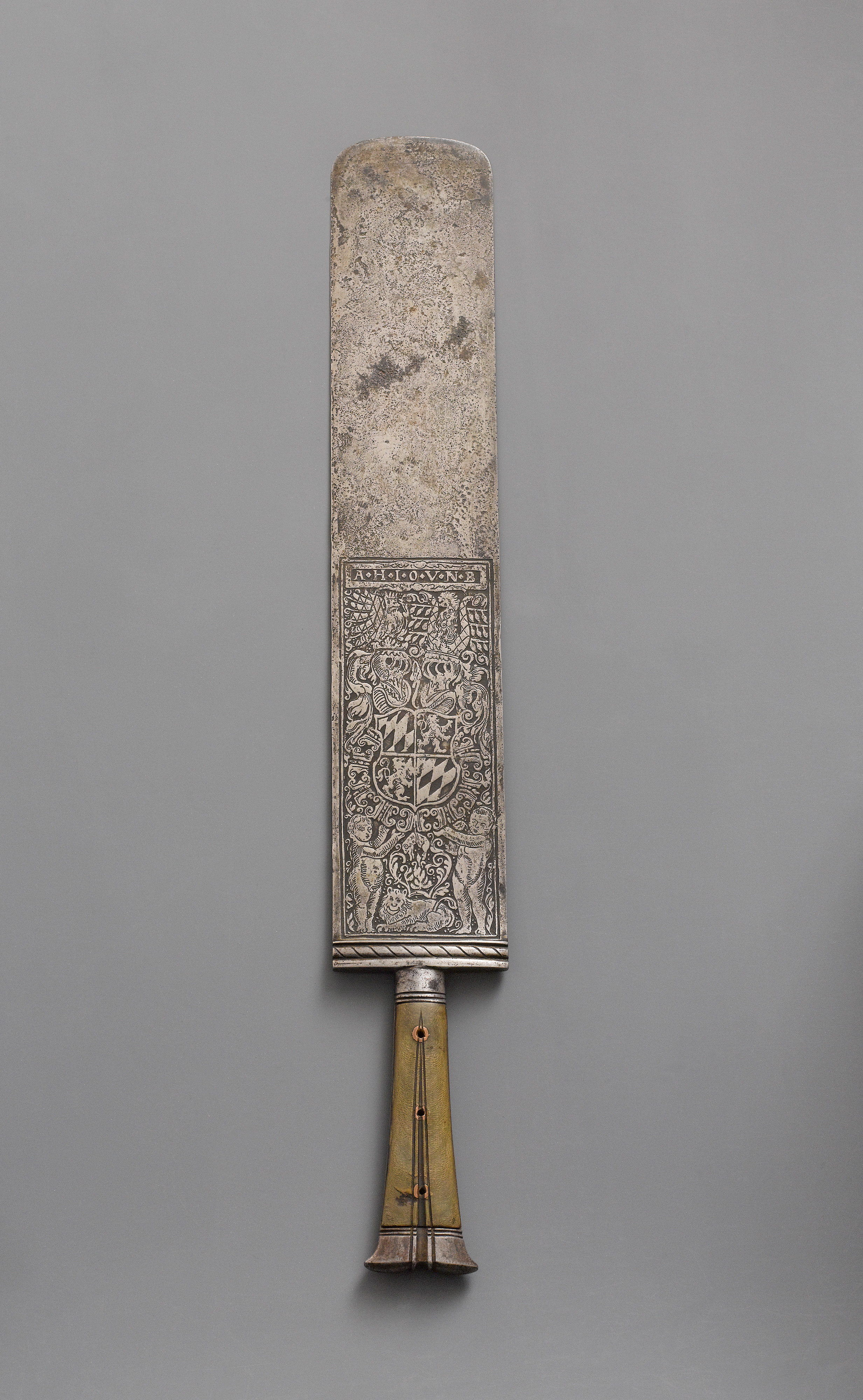Serving Knife
Private collection, Denmark.
South Germany , circa 1550-1575
Steel and green stained horn
Width: 58 mm | Length: 400 mm
Width: 2.3 inch | Length: 15.7 inch
Ref No: 1997
The broad steel blade is decorated on both sides with the etched Bavarian coat of arms and the letters “A.H.I.O.V.N.B”, standing for Duke Albrecht in Upper and Lower Bavaria (29.2.1528 – 24.10.1579 in Munich, from 1550 Duke of Bavaria).
This magnificent serving knife made for Albrecht V is one of the long-lost believed objects of the Munich ducal Kunstkammer of the 16th Century and its former vaunted treasures. During the reign of Albrecht V it was one of the most important accessories of the ceremonial etiquette at the royal court.
The serving knife belonging to Albrecht V is one of the long-lost treasures from the 16th-century ducal art chamber in Munich. During Albrecht V’s reign, this magnificent presentation knife was one of the most important accessories at the princely court and was part of ceremonial etiquette. Its designation attests to its direct affiliation with the court. The virtuoso craftsmanship makes this piece a particularly valuable treasure.
Presentation knives rarely survive as pairs. For example, the Germanisches Nationalmuseum owns a pair dated 1551. Albrecht V’s presentation knife formed a pair with its counterpart. We have now located the other knife in the Musée Le Secq des Tournelles collection in Rouen (inv. LS 1999.0.31).
A closely related comparative example is the presentation knife (Inv. No. 21670) belonging to Albrecht V’s son, Duke Wilhelm V of Bavaria, “the Pious” (1548-1626), in the National Museum in Copenhagen. It has a similar blade shape, decoration, and ivory handle. Originally, the serving knife belonged to the collection of Danish King Frederik VII (1848–1863) and passed into the collection of the Oldnordisk Museum (National Museum) after his death.
Carving:
Carving was considered an honourable task, requiring a high level of skill and dexterity. It was often carried out by young aristocrats, who learnt carving alongside fencing, riding and dancing as part of their training at court. Some carvers, or ‘Trancianten’, developed their art to a level of true virtuosity.
Whole poultry were skewered on a fork, carved in the air, and fell apart into artfully arranged individual pieces. Carving utensils were thrown into the air and caught again. Specialised literature for carvers, usually richly illustrated to demonstrate the various cutting techniques, was first published in Italy in the 16th century. However, the role of the ‘carver’ was not primarily to provide entertainment; it was necessary because, in the culinary arts of the time, animals were usually prepared and served whole. Furthermore, it was considered dishonourable for high-ranking guests at a princely table to use a knife themselves during a meal. The carver therefore not only cut up the roast, but also divided it into bite-sized pieces and presented them to the guests.
The role of carver emerged in the 15th century as court offices became more specialised, evolving from the office of steward, one of the four highest offices in the Middle Ages. Even in the 17th century, on particularly solemn occasions, carving for the prince was performed by a high-ranking nobleman.
Tasting:
From the Middle Ages to the 18th century, the fear of being poisoned during meals often dominated rulers’ tables. Thus, princely meals were preceded by a special tasting and testing ceremony to check for poison. Cupbearers and carving masters had to taste the food or touch it with materials that were believed to have magical powers and be able to detect poison; serving knives therefore had handles made of horn, ivory, serpentine or coral.
On behalf of Duke Albrecht V, 15 large etchings were created to depict the wedding celebrations of his son, Crown Prince Wilhelm of Bavaria, and Princess Renata of Lorraine. The wedding supper took place in the newly built St George’s Hall, where the ducal family took their seats at the table, surrounded by the court and served by them.
A gold and red brocade canopy at the end of the table marked the most distinguished place reserved for the newlyweds at the wedding feast. In front of the opposite wall stood a two-tiered sideboard, with a large serving table between them on which platters, covered with a second plate, were placed before being served at the table. All the furniture is covered with white damask cloths. The carvers, cupbearers and stewards, who have direct access to the tables, all belong to the Bavarian high nobility and aristocracy. The court chapel was responsible for providing table music.
Compared to the ceremony, hierarchy, and décor of the newly built room, the food itself was a minor matter; forming a new union through table fellowship was more important at the wedding. It stands to reason that Albrecht V’s serving knife would have been used in the table ceremony at this magnificent wedding.
Provenance:
Presumably from the collection of Richard Zschille (1847–1903), Großenhain. The cutlery collection was auctioned in 1900; the auction catalogue contains the following description under item 26: ‘Couteau de chasse dit présentoir, à lame finement gravée, offrant sur chaque coté les armoiries de la Bavière. Manche en corne. Allemagne, XVI siècle. Longeur: 40 cm.’
The description and length correspond exactly to the presentation knife on offer; unfortunately, there is no illustration in the catalogue. Richard Zschille’s cutlery collection was one of the most important private collections of its kind ever assembled.
Private collection, Denmark.
Literature:
- Ottomeyer, Hans und Michaela Völkel (Hrsg.), Die Öffentliche Tafel, Tafelzeremoniell in Europa 1300 – 1900, exhibition catalogue, Deutsches Historisches Museum, Berlin, 2003.
- Zischka, Ulrike, Ottomeyer, Hans, Bäumler Susanne, Die Anständige Lust von Esskultur und Tafelsitten, 1994.
- Zschille, Richard, Auction cataAuktionskatalog, Paris, Hotel Drouot, 1.-9.11.1900, Lot No. 26; Catalogue De L’Importante Collection De Coutellerie D’Art Œuvres Précieuses porvenant de M. Richard Zschille de Grossenhain.
- Zschille, Richard, Aufstieg & Fall eines Kunstsammlers, exhibion catalogue, Museum Alte Lateinschule, Großenhain, 2006.

